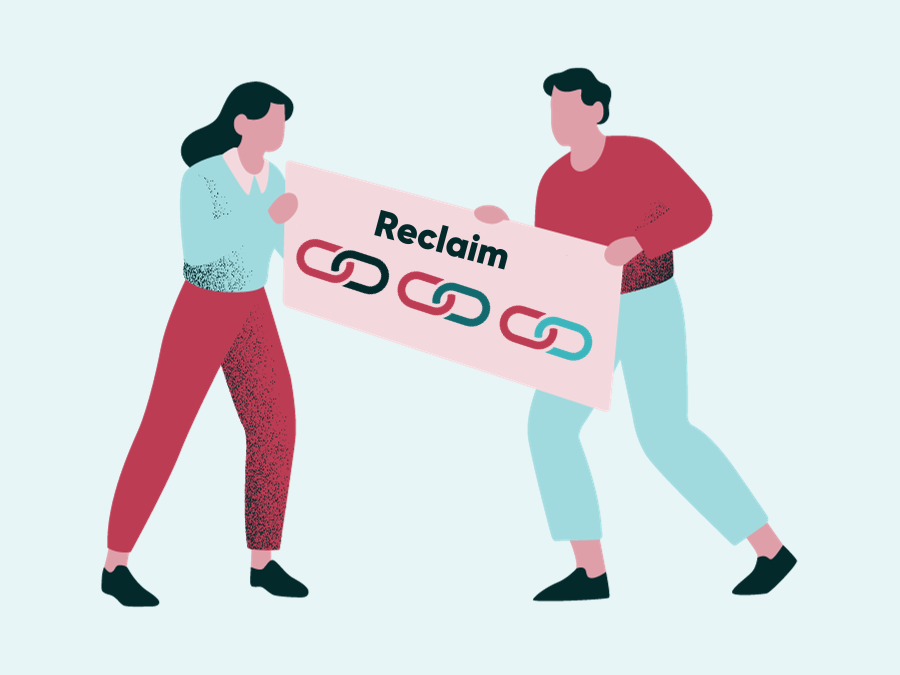
In dynamic digital marketing and SEO, link-building enhances a website’s authority and visibility. Among the numerous tactics available, one that often goes unnoticed but is remarkably effective is link reclamation.
This powerful strategy involves recovering or fixing broken, lost, or uncredited backlinks to your website. It not only aids in restoring lost link equity but also boosts your site’s overall SEO performance, ensuring you make the most of every opportunity for organic traffic.
Now that we understand the importance, let’s explore the details of this powerful SEO strategy.
What Is Link Reclamation?

Link reclamation is a digital marketing strategy for identifying and reclaiming lost or unlinked mentions of a brand, product, or website.
It’s about finding instances where your website or brand is mentioned online but not linked and then contacting the content creators to request that they add a hyperlink.
This process starts with tracking brand mentions across the web using tools like Google Alerts, Ahrefs, or SEMrush. Once these mentions are identified, the next step is to analyze whether they include a link to your site.
If a mention does not include a link, the website owner or content creator is politely contacted to request that one be included.
It empowers you by helping recover backlinks that contribute to search engine optimization (SEO), driving traffic, and improving rankings. It ensures readers can easily navigate the relevant site for more information.
Reclaiming these links is generally more accessible and less resource-intensive than building new links from scratch, giving you control over your SEO strategy.
This strategy can be particularly effective for established businesses with many online mentions but may have missed out on potential backlink opportunities.
By systematically addressing these unlinked mentions, companies can enhance their online presence and leverage existing content for SEO benefits.
The importance of maintaining a solid online presence through link reclamation must be considered, making it a strategy that should be implemented smoothly.
How Can Link Reclamation Be A Life Savior For SEO?
Link reclamation can be a lifesaver for SEO by recovering lost link equity and enhancing website authority. This strategy involves identifying and fixing broken or unlinked mentions of a brand or website across the internet.
When links to your site are removed or URLs are changed without proper redirects, valuable link juice is lost, negatively impacting your search engine rankings.
Reclaiming these links helps restore that lost value, boost organic traffic, and improve domain authority.
It’s a cost-effective SEO tactic that leverages existing content and relationships rather than creating new content or outreach campaigns.
It can enhance user experience by rectifying broken links, ensuring users find relevant content without hassle.
Regular monitoring and maintenance of backlinks guarantee that a site’s link profile remains robust and healthy, safeguarding against penalties from search engines.
By diligently addressing these issues, businesses can maintain a solid online presence, driving more traffic and conversions.
This proactive approach to managing backlinks is crucial for long-term SEO success, making link reclamation an indispensable tool in any digital marketing strategy.
Benefits Of Link Reclamation
Link reclamation refers to finding and fixing broken or outdated links that point to your website or content. Here are several benefits:
It Helps You Regain Lost Link Juice
Link reclamation can help you get backlink juice lost due to broken links. This is valuable because link juice is a significant ranking factor for SEO.
Link juice is a link’s power to pass along SEO benefits (like increased rankings and traffic) to other pages on your site.
It Helps Improve Your Link Profile
A well-rounded link profile is vital for good SEO. Link reclamation can help improve your profile by adding new, high-quality links.
By regularly reclaiming lost links, you can keep a close eye on your link profile and ensure it’s in good shape. It will also alert you to any link-building opportunities you have missed.
Saves Time
Link reclamation is a time-saving SEO strategy because it lets you quickly find and fix broken links. This is especially helpful if you have a significant link profile.
It Helps In Being Safe From Penalties
If you have a lot of low-quality or broken links pointing to your site, it could trigger a Google penalty. Link reclamation can help you avoid this by repairing broken links and improving your link profile.
Few Google updates, such as Penguin, focus on link quality, so link reclamation has become even more critical.
It Can Help You Rank For New Keywords
Link reclamation can also help you rank for new keywords. This is because link building is an important ranking factor for SEO. By reclaiming lost links and adding new ones, you can improve your link profile and, as a result, your rankings.
How To Find Lost Backlinks
Finding lost backlinks is crucial for maintaining and improving your website’s SEO. Here’s a comprehensive guide to help you identify and recover lost backlinks:
1. Use SEO Tools
Various SEO tools can help you track and find lost backlinks:
- Ahrefs:
- Go to Ahrefs’ Site Explorer.
- Enter your website URL.
- Navigate to the “Backlinks” report.
- Use the “Lost” filter to see backlinks that have been lost over a specified period.
- SEMrush:
- Open SEMrush and enter your website URL.
- Go to the “Backlink Analytics” section.
- Select the “Lost” tab to view backlinks that have recently disappeared.
- Moz:
- Access the Link Explorer.
- Enter your domain.
- Use the “Lost Links” section to identify missing backlinks.
2. Google Search Console
- Log in to your Google Search Console account.
- Navigate to “Links” under the “Legacy tools and reports” section.
- Check the “Top linked pages” report for any significant backlink drops.
- Compare historical data to identify the specific links that have been lost.
3. Monitor Your Backlink Profile Regularly
- Use backlink monitoring tools like Monitor Backlinks or Linkody, which notify you when backlinks are lost.
- Set up alerts to receive email notifications whenever a backlink is lost.
4. Identify the Reason for Lost Backlinks
Understanding why a backlink was lost can help you take appropriate action:
- Page Removal: The linking page might have been removed.
- Content Changes: The content of the linking page might have been updated.
- Website Changes: The linking website might have undergone a redesign or migration.
- Manual Removal: The webmaster might have manually removed your link.
5. Reach Out to Webmasters
If a valuable backlink has been lost:
- Contact the webmaster of the site that initially linked to you.
- Politely request reinstatement of the link, providing the original URL and context for why the link was valuable.
- Offer updated content or new insights if the link was removed due to content changes.
6. Check for 404 Errors
- Use tools like Screaming Frog to identify 404 errors on your site.
- Redirect any 404 pages that previously had backlinks to relevant, active pages on your site using 301 redirects.
7. Analyze Competitor Backlinks
- Use tools like Ahrefs or SEMrush to analyze your competitors’ backlinks.
- Identify opportunities where you can gain new backlinks similar to those that were lost.
8. Maintain Quality Content
- Regularly update and improve your content to ensure it remains valuable and relevant.
- High-quality content is more likely to retain backlinks and attract new ones.
9. Build New Backlinks
While recovering lost backlinks, continuously work on building new ones:
- Create shareable content (infographics, research reports, etc.).
- Engage in guest blogging.
- Participate in relevant forums and communities.
Why Use A Link Reclamation Strategy?
Here are several reasons:
- Recover Lost Link Equity:
- Over time, websites change or move, leading to broken links or links pointing to outdated URLs. Reclaiming these links helps regain lost link equity, essential for maintaining and improving your search engine rankings.
2. Improve SEO Rankings:
- Quality backlinks are a significant factor in search engine algorithms. By reclaiming links, you ensure that your website continues to benefit from its SEO value, which can lead to better search engine rankings and increased organic traffic.
3. Enhance User Experience:
- Broken or misdirected links can frustrate users and lead to a poor user experience. By fixing these links, you ensure that users can easily access the content they seek, leading to higher satisfaction and potentially higher conversion rates.
4. Maximize Existing Content Value:
- If you have valuable content that previously attracted backlinks, ensuring those links are still active maximizes the return on investment in that content. This can lead to sustained or increased traffic without creating new content.
5. Efficient Use of Resources:
- Link reclamation is often more cost-effective and quicker than acquiring new backlinks. It leverages existing relationships and content, making it an efficient way to maintain or improve your backlink profile.
6. Strengthen Relationships with Webmasters:
- Reaching out to web admins to fix broken links can foster positive relationships. These relationships can benefit future collaborations, guest posting opportunities, or acquiring new backlinks.
7. Identify Technical Issues:
- During the link reclamation process, you may uncover technical issues on your website, such as 404 errors or incorrect redirects. Fixing these issues can improve your site’s overall health and performance.
8. Increase Referral Traffic:
- Reclaimed links can drive direct referral traffic to your site. Users clicking on these links from other sites will likely be interested in your content, leading to higher engagement and potential conversions.
Why Do We Lose Backlinks?

Losing backlinks can happen for several reasons, and understanding these reasons can help in managing and potentially preventing their loss:
- Link Removal by the Website Owner: Sometimes, the linking website owner may intentionally remove your backlink. This could happen if they update their content, restructure their website, or remove references to external sites.
- Expired Domain: If the domain linking to your site expires and is not renewed, the backlink will be lost as the website ceases to exist.
- Changes in Content: If the linking webpage undergoes content changes and your link no longer fits the updated theme or topic, the link might be removed.
- Penalties or Algorithmic Changes: If the linking website is penalized by search engines or its ranking drops significantly due to algorithm updates, it might lead them to remove links to other sites, including yours.
- No-Follow Attribute: Websites may change your backlink to a “no-follow” link, which doesn’t pass SEO value to your site. This could happen if they comply with search engine guidelines or for other reasons.
- Link Rot: Sometimes, links are lost due to technical issues such as broken links or server problems on the linking site.
- Content Updates: If your content that was initially linked to is updated or removed, the link may become irrelevant or broken, prompting the linking site to remove it.
- Mistakes or Oversight: Occasionally, link removals can be accidental or due to administrative errors during website updates or migrations.
Final Thoughts
Link reclamation is a powerful yet often overlooked SEO strategy that can significantly benefit your website.
By identifying and reclaiming lost or broken links, you maintain your website’s authority and improve its SEO performance and user experience.
Incorporate link reclamation into your SEO arsenal to ensure that every link pointing to your site contributes positively to your online presence.
Mastering link reclamation is not just about fixing broken links; it’s about safeguarding and optimizing your website’s SEO potential.
Start implementing these strategies today to reclaim lost links and enhance your website’s authority in the digital landscape.
If you have questions, please leave them in the comment section. We will be happy to answer you.
Thanks for reading:)


